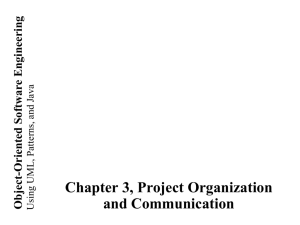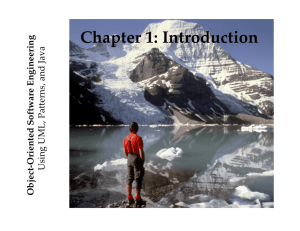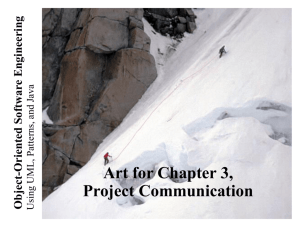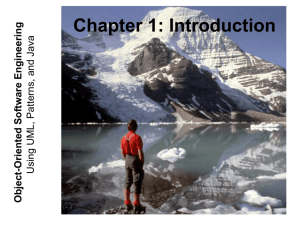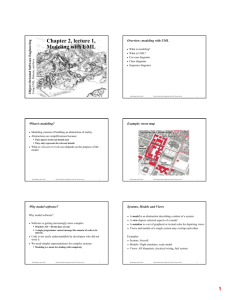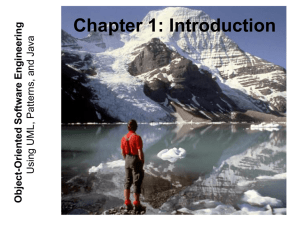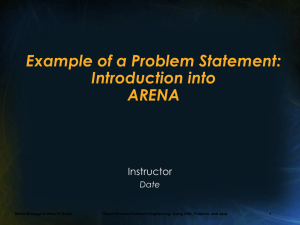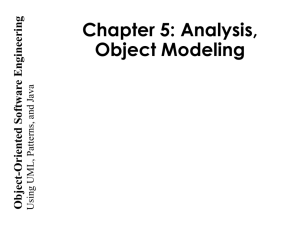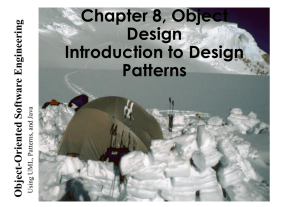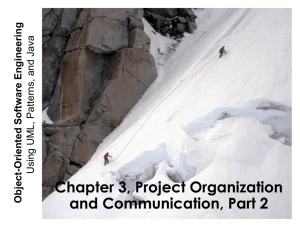Object Modeling
advertisement
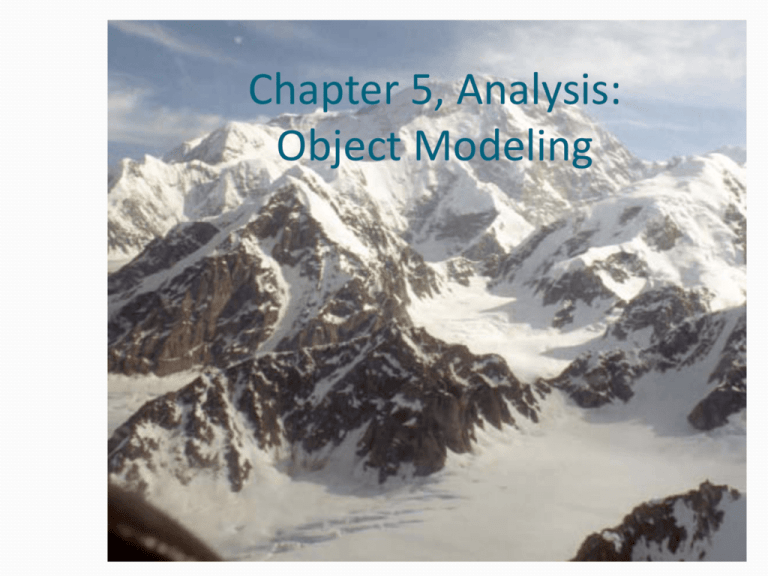
Chapter 5, Analysis: Object Modeling Aperçu Rappel Modélisation du système = modélisation fonctionnelle + modélisation objet + modélisation partie ‘dynamique’ Maintenant: Modélisation des objets du domaine La partie statique (diagramme de classe) La partie dynamique Bernd Bruegge & Allen H. Dutoit Object-Oriented Software Engineering: Using UML, Patterns, and Java 3 Aperçu Maintenant: Modélisation des objets du domaine La partie statique (diagramme de classe) Les activités durant la modélisation des objets L’identification des objets et classes du domaine Les différents types d’objets Objets Entity, boundary, control L’identification des relations, attributs et méthodes La partie dynamique Diagramme de séquence à partir des scénarios abstraits Description du comportement d’une classe avec une machine à état (diagramme d’état) Bernd Bruegge & Allen H. Dutoit Object-Oriented Software Engineering: Using UML, Patterns, and Java 4 I cannot follow the lectures. Where are we? We have covered Ch 1 – 2 and Ch 4 Identifying Actors, Concrete Scenarios and describing Use Cases with flow of events/abstract scenarios We are now starting Chapter 5 From use cases to class diagrams Identify participatory objects in flow of events descriptions Identify entity, control and boundary objects Heuristics to find these types: Ch 5, Section 5.4 Then we moving into dynamic modeling Notations for dynamic models are Interaction-, Communication-, Statechart-, Activity diagrams, Reread Ch. 2, pp. 62-68 Bernd Bruegge & Allen H. Dutoit Object-Oriented Software Engineering: Using UML, Patterns, and Java 5 Introduction (Ch 1-3) OOSEGalaxy Requirements Elicitation (Ch.4 ) Nonfunctional Requirements Functional Model Use Case Diagrams Analysis (Ch.5) “Analysis Cloud” Class Diagrams Analysis Object Model System Design ( Ch.6 & 7 ) Bernd Bruegge & Allen H. Dutoit Statechart Diagrams Dynamic Model Sequence Diagram Object-Oriented Software Engineering: Using UML, Patterns, and Java 8 Activities during Object Modeling Main goal: Find the important abstractions Steps during object modeling 1. Class identification Based on the fundamental assumption that we can find abstractions 2. Find the attributes 3. Find the operations 4. Find the associations between classes Order of steps Goal: get the desired abstractions Order of steps is secondary What happens if we find the wrong abstractions? We iterate and revise the model. Bernd Bruegge & Allen H. Dutoit Object-Oriented Software Engineering: Using UML, Patterns, and Java 9 Class Identification Class identification is crucial to object-oriented modeling Helps to identify the important entities of a system Basic assumptions: 1. We can find the classes for a new software system (Forward Engineering) 2. We can identify the classes in an existing system (Reverse Engineering) Why can we do this? Philosophy, science, experimental evidence. Bernd Bruegge & Allen H. Dutoit Object-Oriented Software Engineering: Using UML, Patterns, and Java 10 Class Identification Approaches Application domain approach Ask application domain experts to identify relevant abstractions Syntactic approach Start with use cases Analyze the text to identify the objects Extract participating objects from flow of events Design patterns approach Identify relevant abstractions that can be reused (apply design knowledge) Component-based approach Identify existing solution classes. Bernd Bruegge & Allen H. Dutoit Object-Oriented Software Engineering: Using UML, Patterns, and Java 11 Class identification is a Hard Problem One problem: Definition of the system boundary: Which abstractions are outside, which abstractions are inside the system boundary? Actors are outside the system Classes/Objects are inside the system An other problem: Classes/Objects are not just found by taking a picture of a scene or domain The application domain has to be analyzed Depending on the purpose of the system different objects might be found Q: How can we identify the purpose of a system? A: Scenarios and use cases => Functional model. Bernd Bruegge & Allen H. Dutoit Object-Oriented Software Engineering: Using UML, Patterns, and Java 12 There are different types of Objects Entity Objects Represent the persistent information tracked by the system (Application domain objects, also called “Business objects”) Boundary Objects Represent the interaction between the user and the system Control Objects Represent the control tasks performed by the system. Bernd Bruegge & Allen H. Dutoit Object-Oriented Software Engineering: Using UML, Patterns, and Java 13 Example: 2BWatch Modeling To distinguish different object types in a model we use the UML Stereotype mechanism Year Button ChangeDate Month LCDDisplay Day Entity Objects Bernd Bruegge & Allen H. Dutoit Control Object Boundary Objects Object-Oriented Software Engineering: Using UML, Patterns, and Java 14 Naming Object Types in UML <<Entity>> Year <<Control>> ChangeDate <<Entitity>> Month <<Boundary>> LCDDisplay <<Entity>> Day Entity Object <<Boundary>> Button Control Object Boundary Object XxxCtrl XxxBoundary Or use suffixes: none Icons for Object Types: Entity, Control and Boundary Object We can also use icons to identify a stereotype When the stereotype is applied to a UML model element, the icon is displayed beside or above theSystem Boundary name Year ChangeDate Entity Object Control Object Bernd Bruegge & Allen H. Dutoit Button Boundary Object Object-Oriented Software Engineering: Using UML, Patterns, and Java WatchUser Actor 16 UML is an Extensible Language Stereotypes allow you to extend the vocabulary of the UML so that you can create new model elements, derived from existing ones Other Examples: Stereotypes can also be used to classify method behavior such as <<constructor>>, <<getter>> or <<setter>> To indicate the interface of a subsystem or system, one can use the stereotype <<interface>> (Lecture System Design) Stereotypes can be represented with icons as well as graphics: This can increase the readability of UML diagrams. Bernd Bruegge & Allen H. Dutoit Object-Oriented Software Engineering: Using UML, Patterns, and Java 17 Object Types allow us to deal with Change Having three types of object leads to models that are more resilient to change The interface of a system changes more likely than the control The way the system is controlled changes more likely than entities in the application domain Object types originated in Smalltalk: Model, View, Controller (MVC) Model <-> Entity Object View <-> Boundary Object Controller <-> Control Object Next topic: Finding objects. Bernd Bruegge & Allen H. Dutoit Object-Oriented Software Engineering: Using UML, Patterns, and Java 20 Bernd Bruegge & Allen H. Dutoit Object-Oriented Software Engineering: Using UML, Patterns, and Java 21 Finding Participating Objects in Use Cases (1) Pick a use case and look at flow of events Do a textual analysis (noun-verb analysis) Nouns are candidates for objects/classes Verbs are candidates for operations This is also called Abbott’s Technique Bernd Bruegge & Allen H. Dutoit Object-Oriented Software Engineering: Using UML, Patterns, and Java 22 Finding Participating Objects in Use Cases (2) After objects/classes are found, identify their types Identify real world entities that the system needs to keep track of (FieldOfficer Entity Object) Identify real world procedures that the system needs to keep track of (EmergencyPlan Control Object) Identify interface artifacts (PoliceStation Boundary Object). Bernd Bruegge & Allen H. Dutoit Object-Oriented Software Engineering: Using UML, Patterns, and Java 23 Example for using the Technique Flow of Events: The customer enters the store to buy a toy It has to be a toy that his daughter likes and it must cost less than 50 Euro He tries a videogame, which uses a data glove and a head-mounted display. He likes it An assistant helps him The suitability of the game depends on the age of the child His daughter is 3 years old The assistant recommends another type of toy, the boardgame “Monopoly". Bernd Bruegge & Allen H. Dutoit Object-Oriented Software Engineering: Using UML, Patterns, and Java 24 Mapping grammatical constructs to model components (Abbot’s Technique) Example “Monopoly” Toy Buy, recommend Grammatical construct Proper noun Improper noun Doing verb UML model component object class operation Is a being verb inheritance has an having verb aggregation must be modal verb constraint dangerous adjective attribute enter transitive verb operation depends on intransitive verb Constraint, class, association Bernd Bruegge & Allen H. Dutoit Object-Oriented Software Engineering: Using UML, Patterns, and Java 25 Generating a Class Diagram from Flow of Events Customer Customer store ? enter() daughter age Flow of events: The customer enters the store toy It has to be a to buy a toy. toy that his daughter likes and it must cost less less than than 50 50 Euro. videogame which He tries a videogame, uses a data glove and a headmounted display. He likes it. suitable * toy toy price buy() buy() like() videogam e boardgame An assistant helps him. The depends suitability of the game depends on the age of the child. His daughter is only 3 years old. The assistant recommends another type of toy toy, namely a boardgame. boardgame The customer buy the game and leaves the store Ways to find Objects Syntactical investigation with Abbot‘s technique: Flow of events in use cases Problem statement Use other knowledge sources: Application knowledge: End users and experts know the abstractions of the application domain Solution knowledge: Abstractions in the solution domain General world knowledge: Your generic knowledge and intuition Bernd Bruegge & Allen H. Dutoit Object-Oriented Software Engineering: Using UML, Patterns, and Java 27 Order of Activities for Object Identification 1. Formulate a few scenarios with the help from an end user or application domain expert 2. Extract the use cases from the scenarios, with the help of an application domain expert 3. Then proceed in parallel with the following: Analyse the flow of events in each use case using Abbot's textual analysis technique Generate the UML class diagram. See next slide Bernd Bruegge & Allen H. Dutoit Object-Oriented Software Engineering: Using UML, Patterns, and Java 28 Steps in Generating Class Diagrams 1. Class identification (textual analysis, domain expert) 2. Identification of attributes and operations 3. 4. 5. 6. (sometimes before the classes are found!) Identification of associations between classes Identification of multiplicities Identification of roles Identification of inheritance Bernd Bruegge & Allen H. Dutoit Object-Oriented Software Engineering: Using UML, Patterns, and Java 29 Who uses Class Diagrams? Purpose of class diagrams The description of the static properties of a system The main users of class diagrams: The application domain expert uses class diagrams to model the application domain (including taxonomies) during requirements elicitation and analysis The developer uses class diagrams during the development of a system during analysis, system design, object design and implementation. Bernd Bruegge & Allen H. Dutoit Object-Oriented Software Engineering: Using UML, Patterns, and Java 30 Who does not use Class Diagrams? The client and the end user are usually not interested in class diagrams Clients focus more on project management issues End users are more interested in the functionality of the system. Bernd Bruegge & Allen H. Dutoit Object-Oriented Software Engineering: Using UML, Patterns, and Java 31 Summary System modeling Functional modeling + object modeling + dynamic modeling Functional modeling From scenarios to use cases to objects Object modeling is the central activity Class identification is a major activity of object modeling Easy syntactic rules to find classes and objects Abbot’s Technique Class diagrams are the “center of the universe” for the object-oriented developer The end user focuses more on the functional model and usability. Bernd Bruegge & Allen H. Dutoit Object-Oriented Software Engineering: Using UML, Patterns, and Java 32
